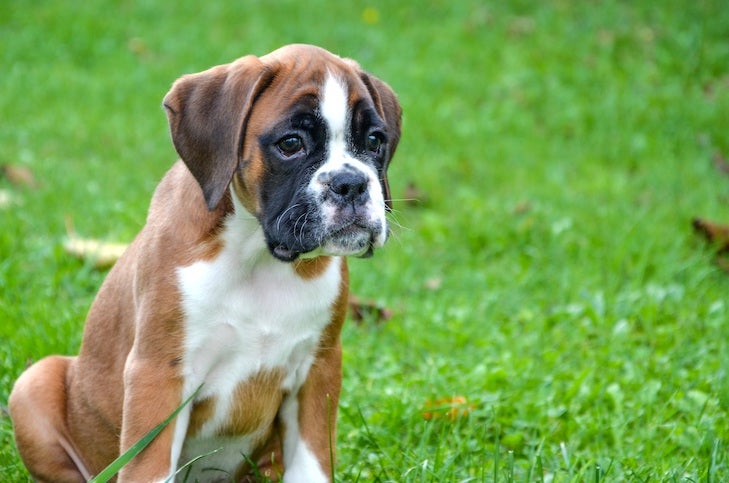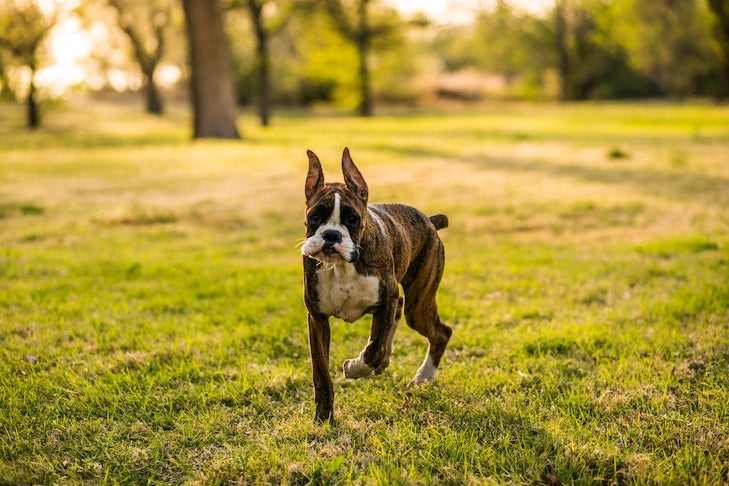With their chiseled features, muscular bodies, and square jaws, Boxers are the movie stars of the dog world. These handsome pups are known for their loyalty, quick wit, and protective nature, but these charming characteristics also mean Boxer pups have a few special considerations when it comes to training and socialization.
We spoke with several Boxer experts, including the American Boxer Club’s Publicity Chairperson and their Dean of Boxer U, Virginia Shames to get some advice on raising these wonderful dogs.
Growth Stage: Between 8–16 weeks
Training Goal #1: Socialize Boxers with Dogs and People
Boxers are fiercely protective of their owners, so proper socialization is a necessity. “Socialization begins the moment the puppy enters their new home,” says Shames. “Boxers are very social dogs if introduced properly.”
Debra Henkle, dog trainer and owner of Vendetta Boxers in Vallejo, California, recommends owners start introductions to friendly people and pets with a few caveats. “Puppies won’t likely have all their shots until they are 16 weeks old, so make sure visitors haven’t been to places like dog parks, pet stores, vets or other spots they could have been exposed to dogs who may be sick,” she advises.
You’ll also want to enroll in the AKC Family Dog Program, because it’s a great way to socialize your pooch. “Most training clubs allow puppies as young as eight weeks old to enroll if you provide proof of the dog’s first shots, which I highly recommend,” says Henkle.
Training Goal #2: Get Boxers Used to Grooming
Although Boxers are short-haired dogs who are easy to keep clean, many drool, so you’ll need to get them used to basic grooming. “Using a dampened washcloth, gently wipe between the folds on the muzzle and under the dewlaps to clean up that drool,” recommends dog trainer and behaviorist Lynda Taylor of Breed Advisor. You can also wipe down their coat and paws between baths to remove any dirt, says Shames.
Most importantly, you’ll want your little Boxer puppy to associate brushes and washcloths with positive rewards like food and praise so that these grooming tools won’t seem scary, recommends dog trainer Russell Hartstein, owner of Fun Paw Care Dog Training in Los Angeles, California. “Also, get the pup used to being touched on the muzzle, toes, body, tail, and hindquarters because these are areas you’ll touch during baths and that your vet will check during exams,” he says.

Training Goal #3: Teach Your Boxer Basic Obedience
Boxers were originally bred to hunt large prey like wild boar and bison, so you don’t want them to channel their natural instincts into destructive behaviors like hunting your shoes and stealing your snacks. “Boxers are bright and energetic, so start teaching them basic obedience commands like ‘Sit,’ ‘Stay,’ and ‘Come,’ immediately after bringing them home,” advises Hartstein.
Henkle recommends consistency when it comes to training Boxers. “They love to learn but can be stubborn and respond best to reward-based positive reinforcement training,” she says. Yummy rewards like small pieces of chicken or hot dog work best. “The more you train Boxers, the better they’ll be and the less chance they’ll get bored and destructive.”
Puppy Stage: By 6 Months
By this age, your Boxer pup should have lots of new human and canine friends, be a pro at basic obedience, and enjoy regular grooming.
Training Goal #4: Potty Train Your Boxer
Boxers are fastidiously clean and take quickly to potty training. “Remember that your puppy will need to potty within five to 15 minutes of eating, drinking, sleeping or playing,” says Henkle. She recommends taking puppies to the same potty spot each time. Once they go, reward them with a treat or praise.
Because Boxers are so clean, crate training is a vital part of potty training for them, advises Hartstein. The crate should provide puppies with a Zen environment where they can sleep. “Boxers won’t want to soil where they sleep,” he says. Just make sure that the crate is big enough to let your pup stand up, turn around, and stretch out. And don’t keep them in there for more than four hours at a time, advises Henkle.
Training Goal #5: Teach Advanced Commands to Your Boxer
Boxers are whip-smart and energetic. “Teaching them tricks is a great way to channel their boundless energy,” says Taylor.
Most importantly, ensure your Boxer knows the “Stay” and “Come” commands reliably to prevent these escape-artist pups from making a run for it while in your yard, even if it’s fenced.
Boxers make excellent candidates for the AKC Canine Good Citizen Program after they graduate from the AKC S.T.A.R. Program, which helps teach them all of the basics and sets them up for success with more advanced commands, recommends Hartstein.

Training Goal #6: Regulate Exercise for Your Boxer
Although Boxer puppies are like wind-up toys in terms of their activity level, it’s best not to let them overexert themselves until they’re fully grown. “Because Boxers are a late-maturing breed with growth plates not fully developed until at least 18 months old, extreme performance activities should be limited until maturity,” cautions Shames.
Instead, stick to leisurely walks, games of fetch, hide-and-seek, and provide them with a bevy of interactive toys. “Boxers are inquisitive and are easily entertained by toys but equally happy to play with children or go on long walks with their family,” says Shames.
Growth Stage: By One Year
By one-year-old, your Boxer should have mastered many new skills, be completely potty trained, and enjoy meeting new people and pets.
Training Goal #7: Get Your Boxer Involved with AKC Sports & Activities
Because of their intelligence and eagerness to please, Boxers make excellent competitors in all kinds of AKC activities. “In addition to AKC Obedience and AKC Agility, currently Boxers have been very successful in AKC Barn Hunt, Herding, Dock Diving, Fast CAT, and Tracking competitions, thus proving the diversity of Boxer adaptations and enthusiasm,” says Shames. “Boxers also are extremely competent in scent work and have been exceptional in serving as therapy dogs.”
Training Goal #8: Avoid Extreme Temperatures with Boxers
Boxers are a brachycephalic breed with a very short coat, so they are sensitive to extreme temperatures, warns Shames. “It’s necessary to keep them well-hydrated and not expose them to intense heat and sunshine for an extended time,” she says. And that short coat doesn’t provide much protection against the cold, so it’s best to get them a stylish coat during chilly weather.
Don’t miss crucial information when it comes to raising your puppy. Get personalized training, nutritional, veterinary, and everyday advice sent straight to your inbox. Subscribe to Pupdate, a weekly email newsletter with customized content based on your puppy’s breed and age.

